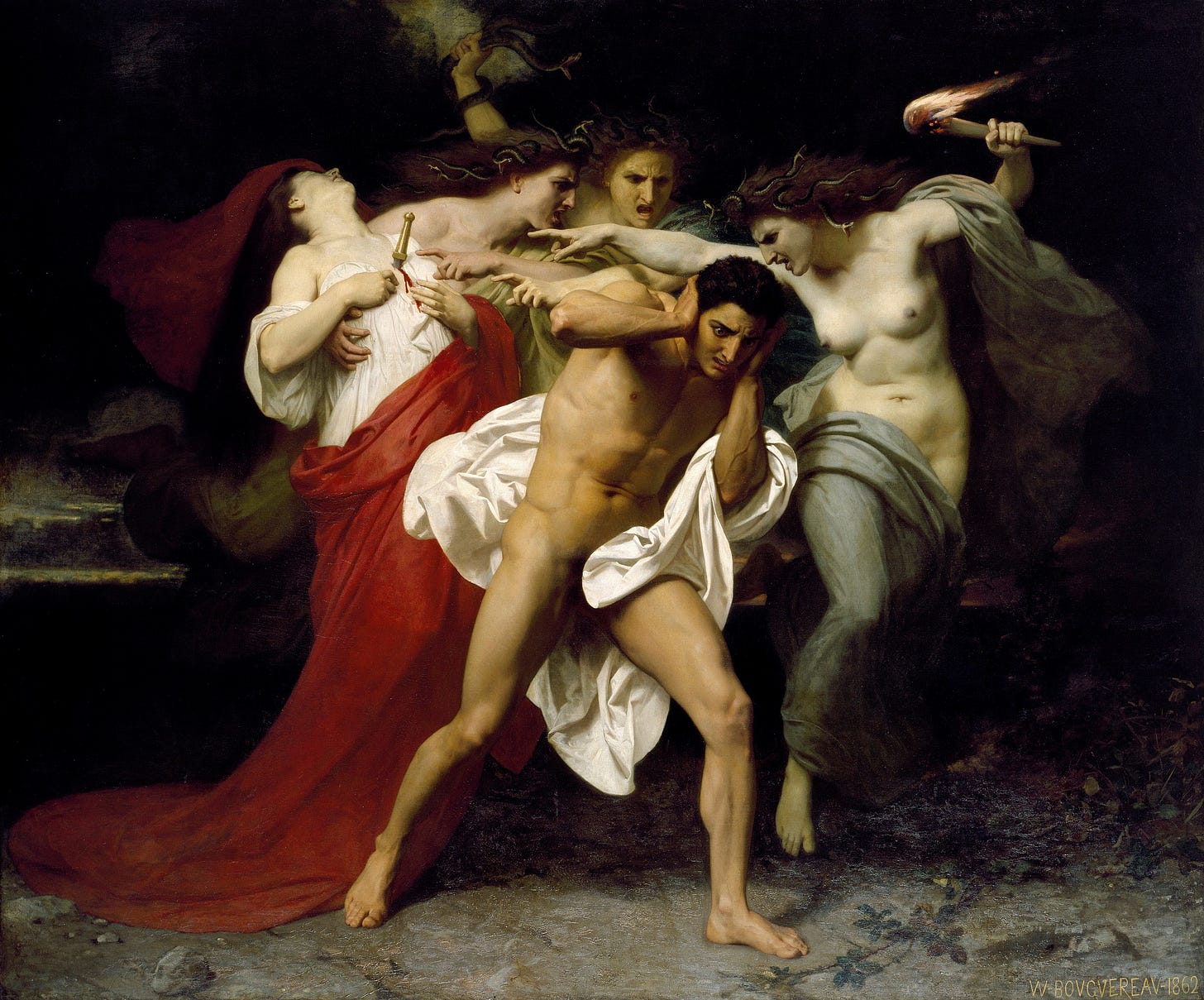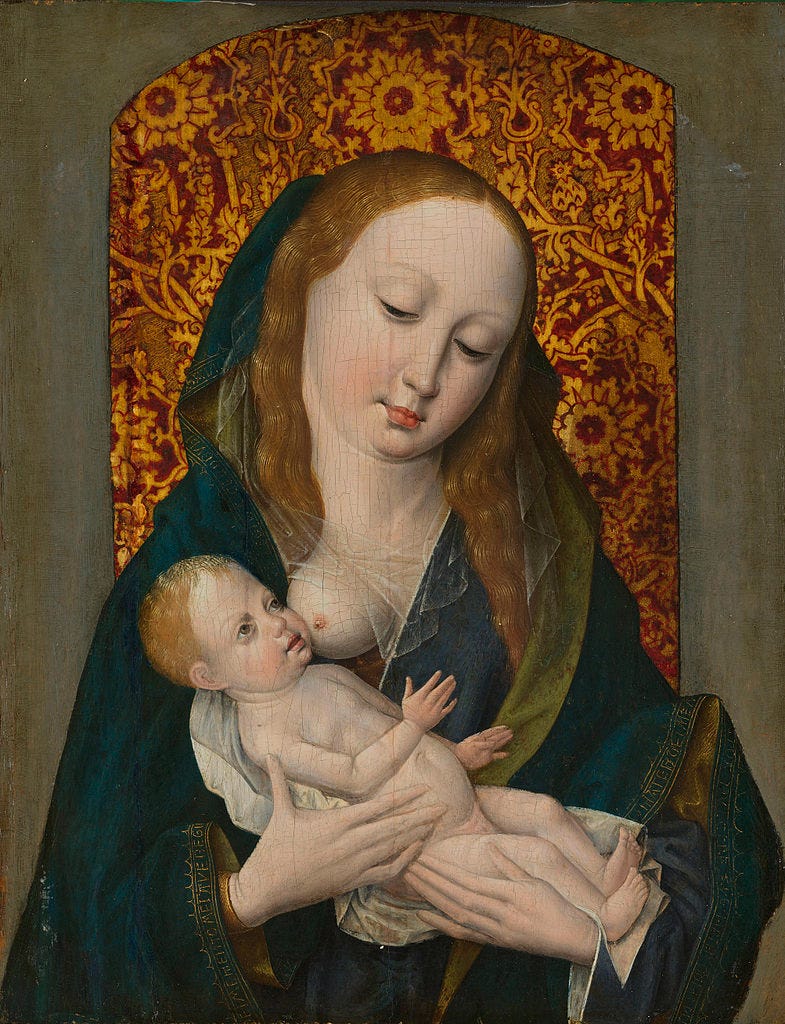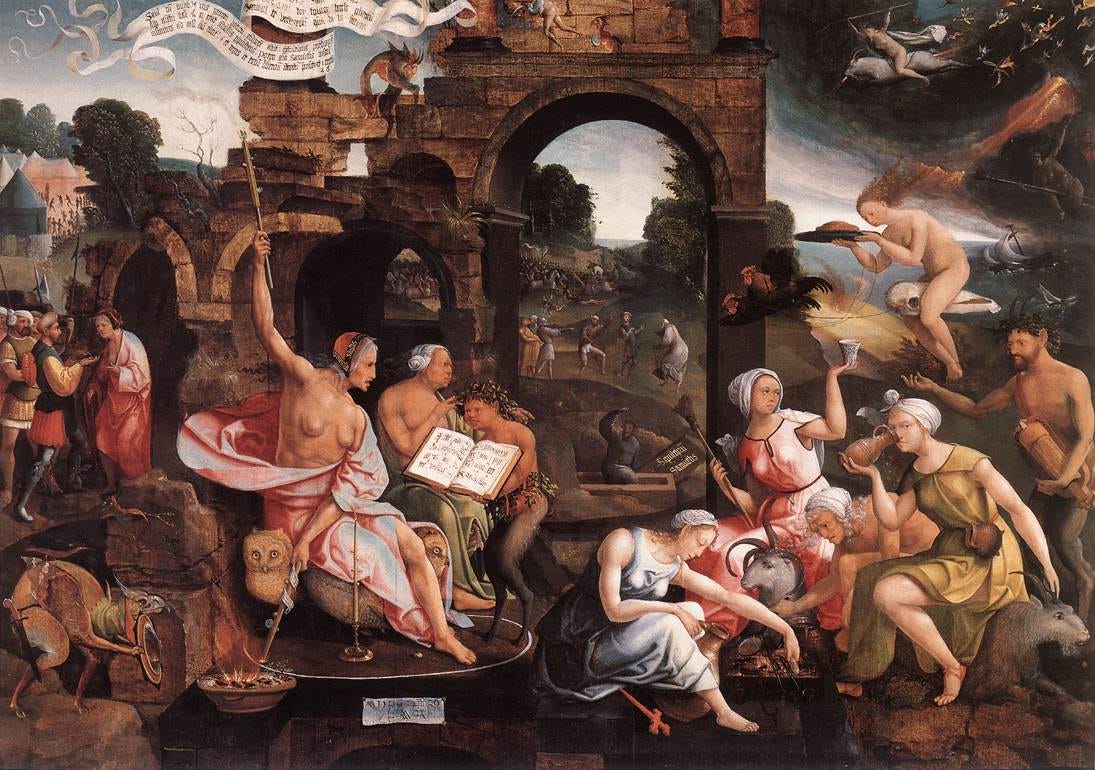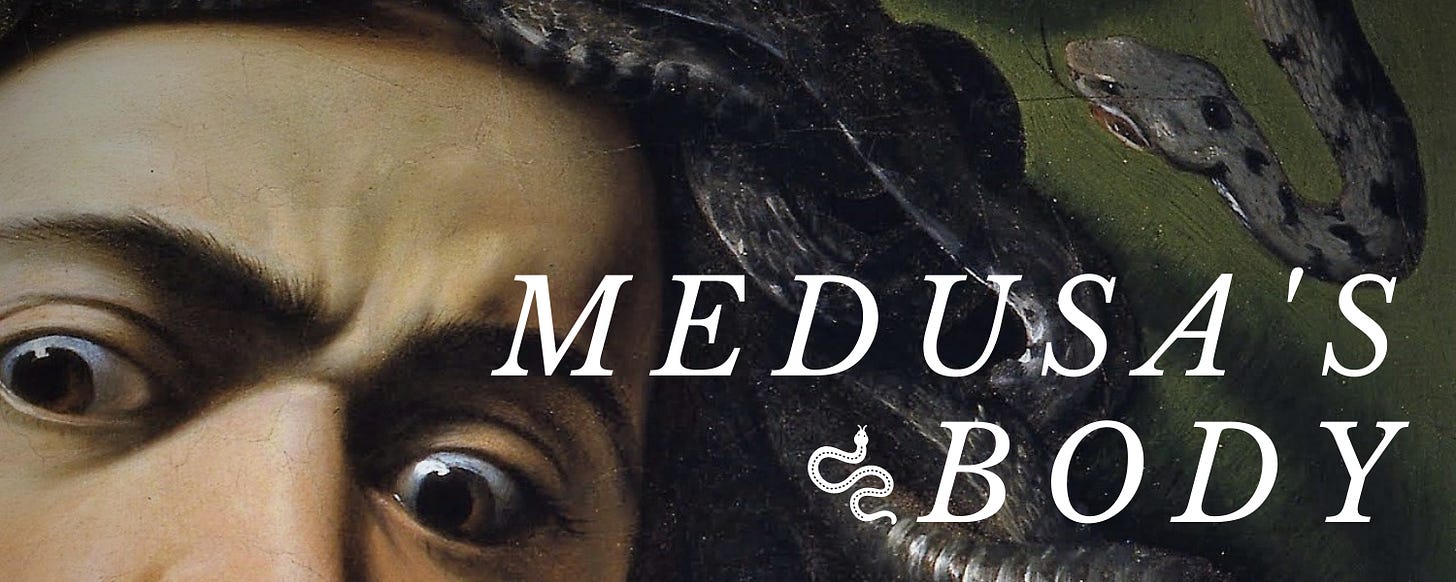The Virgin, the Witch, and a Grotesque Reunion
"The essence of the grotesque is precisely to present a contradictory and double-faced fullness of life."
The Old English word hægtesse means “witch, Fury.” From this word descends the Modern English hag and German hexe. The element hag- is cognate with the Old English haga, meaning “fence, enclosure, portion of woodland marked off for cutting.” Both the Old Norse word for witch tunriða and Old High German zunritha mean, literally, “hedge-rider.” The witch’s body is a borderland.
In October1 I wrote about witches and the destabilizing power of feminine delight. Now, as a Part Two of sorts, I want to ground the image of the witch in the everyday. I want to talk about the witch as an archetypal embodiment of the dark side of feminine power, which is split from the whole and pushed underground into the unconscious.
Splitting…? The unconscious…? Ohh yes, we’re talking about psychoanalysis again.
I recently stumbled upon an episode of the This Jungian Life podcast titled “The Archetype of the Witch: Dangerous, Denied and Dishonored” in which the hosts—Jungian analysts Deborah Stewart, Lisa Marchiano and Joseph Lee—unpack the witch’s enduring hold on the human imagination.
They introduce the archetype via Aeschylus' The Eumenides, wherein Orestes stands trial for killing his mother to avenge his father. In the ancient Greek play, the Furies are the feminine accusers (and tormenters) of Orestes while Apollo is the masculine defense, and Athena presides over the court.

After hearing the arguments, Athena casts the tie-breaking vote to acquit Orestes, declaring that the superiority of the patriarchal principal justifies his vengeance against his mother. The Furies are (naturally) enraged by the verdict and threaten to terrorize Athens, but Athena banishes them to the underworld.
This banishment is ripe for modern interpretation, and what I see is the banishment of feminine rage. We’re told our emotions are messy and disruptive all the time: we’re overdramatic or moody or hysterical when upset and abrasive or shrill or psycho when angry. And these are just reactions to mild displays of feminine emotion. Sports, video games, certain genres of music and ~war~ are masculine spaces where even extreme expressions of emotion are acceptable. Where is our rage supposed to go?
Only half of the human emotional spectrum fits in the box of acceptable femininity that is meant to encloses us, so the expression of negative emotion is repressed.
Deborah Stewart suggests that Athena’s banishment of the Furies to the underworld parallels civilization’s banishment of negative feminine energy to the collective unconscious. According to Carl Jung, the founder of analytical psychology, the collective unconscious is the deepest part of the unconscious as it is not shaped by personal experiences but rather inherited. This level of the psyche is peopled with archetypes that represent universal patterns or images; these are passed down in the same way behavioral patterns or personality traits are passed down.
The Fury/witch is an archetype that embodies the destructive potential of feminine power. The archetype is so fearsome (and so repressed) because she symbolizes our primordial vulnerability to the universal mother in her negative aspect. In her positive aspect, the mother represents creativity, fertility, rebirth, nurturing, all that good stuff. In her negative aspect, she represents destruction and death. The way we talk about “mother nature” is a good example of this duality: we adore her tenderness when flowers bloom but fear the all-consuming chaos of wildfires, tsunamis and earthquakes.
This duality plays a role in the development of the psyche during infancy: the mother keeps the child safe and supplies life-giving milk, so the child sees her as a benevolent god. (Consider that the mother is the infant’s entire universe for the first weeks of life; he literally can’t see anything beyond her face.) When the child is hungry and frustrated, however, he projects his anxiety onto the primary object of his life and believes his mother is persecuting him.
Psychoanalyst Melanie Klein observed children in the early stages of development and described how the infant splits the mother into all-good and all-bad because he lacks the capacity for ambiguity. Klein wrote that the infant splits the mother into the Good Breast and the Bad Breast, projecting the love of met needs onto one and the fear of unmet needs onto the other. If the infant’s needs are consistently met, he happily assumes the Bad Breast has been vanquished. His fear is repressed rather than integrated into his image of the mother.
The process of splitting and projecting is an unconscious attempt to ease paranoid anxieties of persecution, according to Klein. Eventually, the infant’s psyche develops enough for him to grapple with the frustrating ambivalence of life: people are never all-good or all-bad but a blend of both, and experiences are often the result of chance rather than the intentions of others. The infantile association between the fear of chaos and the mother’s power remains, however, buried in the unconscious. (If you’re guessing that this association is a recipe for psychic disaster, you’re right.)
As is the case with many psychological processes that occur during development, splitting recurs in adulthood in response to trauma or stress. We unconsciously project our fears onto other people, resulting in hatred, prejudice and war. We also project positive emotion in order to see only what we want to see, preserving feelings of contentment and safety.
Feelings and experiences lodged in the individual unconscious evolve into archetypes in the collective unconscious. For this reason, the collective mother—call her Mother Nature, the Great Mother, the Universe, Pachamama, Prithvi, Kokyangwuti, Gaia, the Divine Feminine, whatever name gets closest to representing that moment when you think about how deep the ocean is and feel both love and dread at the same time—can also be split into separate positive and negative entities.
As I see it, the collective splitting of the mother archetype is a particularly euro-christian problem.
Christianity banished every pantheon of gods that contained representations of the multifacetedness and ambiguity of human life, resulting in a culture with no well-rounded representations of femininity. The universal mother, which contains both life and death, is split into two archetypes in western christian cultures: the nonsexual, all-good, all-forgiving virgin Mary and the hypersexual, Satanic/evil, vengeful witch.

Many paintings of the Madonna and Child in the western tradition look a lot like the one above. Mary is often depicted with one white breast exposed. One purpose, one meaning, one-sided femininity. Her eyes are downcast and the line of her gaze passes through her breast to the face of her child, as if to confirm that her purpose is to physically frame and nourish him.

In euro-christian cultures, Mary in her passive femininity is the ideal for women, and the witch with her sagging breasts, which provide no nourishment, is the opposite pole. The witch is the destructive Fury banished to the underworld, the scary mommy banished to the unconscious. Though the witch is meant to represent everything women shouldn’t be, she is culturally and psychologically necessary since she affirms the two-sided nature of femininity, of life in general. She is the grotesque hero the western psyche needs!
I discussed this in my last essay so I’ll be brief: Mikhail Bakhtin, the patron saint of this publication, wrote in Rabelais and His World that a “pregnant hag” is an emblematic grotesque figure because she represents “death that gives birth.” The two essential elements of life contained in one unstable, transgressive body. “The essence of the grotesque is precisely to present a contradictory and double-faced fullness of life,” Bakhtin wrote. “Negation and destruction (death of the old) are included as an essential phase, inseparable from affirmation, from the birth of something new and better.”
The nurturing aspect of femininity is easy to accept, but it is difficult for the collective psyche to accept that femininity still exists beyond fertility, and that it should involve aging and death. The universal feminine is grotesque, containing both renewal and degradation, but we choose to celebrate only the renewing aspect.
The infamous Salem witch trials serve as a cautionary tale about what happens when we repress the negative aspect of the grotesque feminine. Many of the colonizers who came to New England were motivated to separate from the Anglican church and establish a religiously pure society. Self-denial was a virtue they believed to be tied up with the success of the colonial project.
Around the turn of the 18th century, the colonizers were dealing with wars with the French and British, wars with indigenous peoples, crop failures and smallpox. Archetypes nestled in the collective unconscious emerge as projections when the conscious level is shaken by external stressors. The colonizers felt threatened from all sides, creating a perfect storm for projections of fearful archetypes like the witch.
“The effect of projection is to isolate the subject from his environment, since instead of a real relation to it there is now only an illusory one,” Jung wrote. The projection of the negative feminine is seen in mass “hysteria” and persecution events—Jung himself suggested a connection between this archetype and the Holocaust. Projecting one’s unbearable sense of vulnerability onto “witches” and putting them on trial as such soothes the vulnerability by creating a clear villain and course of corrective action. It does nothing to correct the true cause of the fear because the true cause is often one of those huge intangibles like chaos, aloneness, nature itself.
As I’m psychoanalyzing the pilgrims, scenes from the 2015 film The Witch bubble up in my mind: in the movie as in many popular interpretations, the witch dwells on the literal fringes of colonial society. She lives in the woods, where the lamplight of civilization/religion ends and the wilderness begins. The witch/hag/fence contrasts the young woman trying her best to be obedient and pure. The drawing out of feminine innocence into the liminal space of the woods signifies a grotesque transgression of the border between good and evil.
Paranoia about some nebulous feminine evil proliferating in society led to the persecution of thousands of people. Ironically, the paranoia brought about the same breakdown of community values, due process and rule of law that the people feared in the first place. If society was not so committed to the infantile belief that goodness and badness cannot exist in the same body, the same community, perhaps there would be fewer borders to violently maintain.
It’s understandable that the infant psyche splits the mother (a baby’s brain is basically a fingerling potato), but the collective splitting of the feminine into the virgin and the witch is a denial of the fullness of life. The existence of chaos lends meaning to beauty, the existence of fear makes joy that much sweeter.
Jung wrote that it is dangerous to leave the dark feminine stuck in the unconscious lest it emerge via projection or physical symptom, but it is also dangerous to open Pandora’s Box and bring it into the world. So what can be done?
According to Jung, the dark, unconscious aspects of the personality (the shadow) can be assimilated into the self through unearthing and interpreting unconscious material, as with psychotherapy or self-led “shadow work.”2
“The shadow is a moral problem that challenges the whole ego-personality, for no one can become conscious of the shadow without considerable moral effort. To become conscious of it involves recognizing the dark aspects of the personality as present and real,” Jung wrote. Acknowledging that there is fear, anger and hatred deep within all of us, attempting to face these things and understand their origin, allows us to live healthier lives than if we try to exist as half of our true selves.
We can’t exorcise the witch from our unconscious because we cannot deny the double-faced fullness of life, which contains both death and birth, both hatred and love. We can, however, attempt to face the witch and all she represents so that we can avoid the pitfalls of projection, and not be destroyed by her.
We can breathe into the witch when we encounter fences that cause anxiety, and allow for emotion to be expressed in a way that benefits us. Rage can be honed, not in the way a blacksmith sharpens a blade but in the way a witch practices a spell, so that when she articulates aloud there is no syllable out of place.
For the benediction, a little assignment: listen to this song. I was angry the other day and listened to this on a fast, stompy, wide-eyed walk. The feeling of catharsis was sublime, but it also allowed me to consider how an orchestra can express disorder with perfect precision.
I struggle with balancing control (which can get pathological for me) and expressing emotion (which sometimes finds me raving like a witch), and this little music lesson helped me understand that it’s less about controlling the trigger or disciplining the emotion itself than it is about skillful expression. Frenzy represented through art. Chaos transformed into meaning.
I’m sorry it’s been so long since I last wrote; I was busy with the holidays and some road-tripping and getting promoted and falling in love.
It fills me with hope to see how “shadow work” is entering popular discourses just like “self care” did a few years ago. I’m seeing content all over the place about meditation, spirituality, and journaling practices aimed at self-knowledge and healing trauma responses. These may be buzzwords that buzz for a while and then fade away like mindfulness coloring books did, but what if “shadow work” prevents the next generation of Karening? (More on that later.)





Well said. People will always need a scapegoat when bad things happen, which leads us to tribalism and the convenient fear/hate of the Other. But it’s sad when the goat is that part of 50% of us that holds the richness of real life, and in fact the very same nature exists in the other half of the population. PS - I approve of your footnotes.
Enjoyably enlightening as always. Probably informed by my upbringing, the encouragement to embrace the duality make me think resolution, even forgiveness.